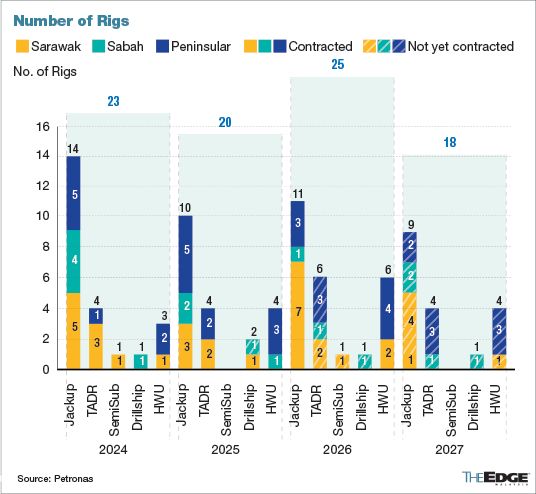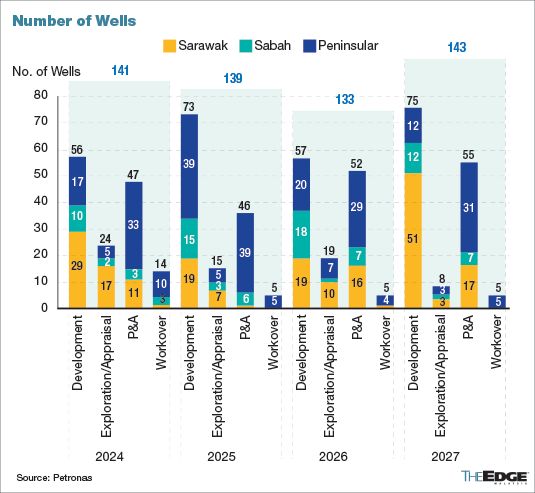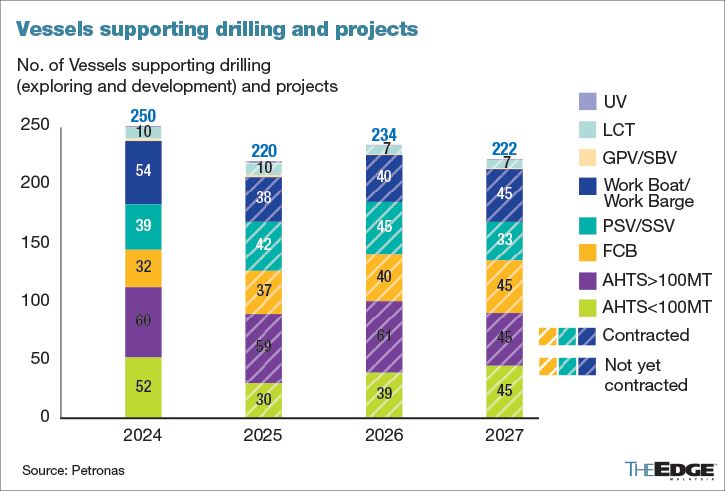
KUALA LUMPUR (Jan 28): Malaysia’s oil and gas (O&G) upstream services segment could anticipate a stable outlook for the next three years, supported by crude oil price projections of US$70-US$80 per barrel, according to the Petronas Activity Outlook 2025-2027.
Among segments with new contract opportunities include the offshore support vessels (OSV) supporting drilling activities, which Petronas said has yet to contract its 2025-2027 requirements. This is despite the possibility of the segment experiencing a 19% drop in expected vessel count for production activites in 2025, compared with its projection from prior year's report.
The O&G industry could also see a dip in the number of drilling rigs required in 2025, than projected in last year’s report, “utilising current available resources in the country”, said Petronas, with 10-11 jack-up rigs contracted up until end-2026.
That said, the number of wells to be drilled is expected to rise slightly in 2025, after the well count in 2024 missed projections, whereas plugging and abandonment activities is expected to dip in 2025, before rebounding from 2026 onwards.
“Generally, 50% of the wells will be executed by jack-up drilling rig, and 20% of the wells will be executed by tender assisted drilling rig.
“Plug and abandonment activity is expected to increase, with aspirations to abandon 80 wells per year from 2028 onwards,” the report read.
The report comes at a time when the federal government, and the state government of Sarawak, a key hydrocarbon producer, are ironing out the details of the roles of Petronas and Sarawak state-owned Petroleum Sarawak Bhd (Petros) in the state’s natural gas ecosystem.
This year’s report provided breakdowns of activities by three geographies, namely Peninsular Malaysia, Sabah and Sarawak, with notable activity level in Sarawak, as well as a highlight of carbon capture opportunities in the state, as well as in Peninsular Malaysia.
“Upstream aims to open up more fields in Malaysia, to pursue its ambition of being a regional centre for CCS (carbon capture and storage) solutions through the Bujang, Inas, Guling, Sepat and Tujoh (BIGST) fields in Peninsular Malaysia.
“The gas supply from the BIGST fields, the first CCS project in Peninsular Malaysia, is another key project for energy security, given the significant potential that exists within the cluster,” it said.
Over the next three years, the national oil and gas operator expects to carry out approximately 367 facilities improvement plans (FIPs) annually.
These include KGA pipeline replacement, HP compressor engineering, procurement construction, installation and commissioning (EPCIC), and F6 rejuvenation project gas turbine generator (GTG) replacement.
The report also projects that there are more than 400 wells that are forecasted to be drilled, and 39 upstream projects are expected to be executed. This includes the construction of three offshore central processing platforms (CPPs), three onshore facilities, and fabrication and installation of approximately 900 kilometres (km)of pipelines.
Among segments not yet contracted include linepipe supplies, amounting to 346.6km in 2025 alone. Other updates include less offshore installation works in 2025; higher hook-up and commissioning man- hours in 2025, which was brought forward from 2024; and stable man-hour outlook for maintenance, construction and modification (MCM) activities.
Petronas vice-president and group procurement Rashidah Alias said in the report that the national oil and gas operator will continue to support the industry in navigating challenges by producing and delivering energy solutions that power society’s progress.
“Petronas aspires to see the industry players thrive in supporting the broader Malaysian oil and gas industry. By co-creating solutions and maintaining open communication, we can drive meaningful change and innovation. Increasing partnerships and leveraging cross-industry experiences, insights and knowledge, will further enhance our capabilities,” she added.
- Pak Lah, the gentleman of politics, passes away at 85
- MOF Inc-owned Pernas appoints former MBSB Bank CEO as new chief
- Malaysian Bar defends Chief Justice amid backlash from former law minister over judicial reform remarks
- China, Vietnam sign deals as Xi visits Hanoi amid US tariff tensions
- Yellen says sell-off in Treasuries shows US confidence loss, not dysfunction



